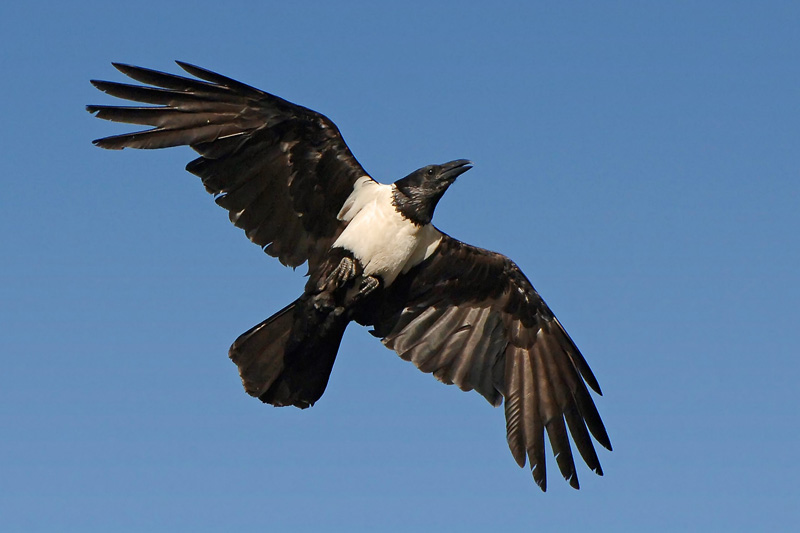|
| Query: reptile | Result: 1743rd of 2585 | |
Pied Crow (Corvus albus) - Wiki
| Subject: | Pied Crow (Corvus albus) - Wiki
| |

| Resolution: 800x533
File Size: 104923 Bytes
Date: 2005:12:12 20:12:30
Upload Date: 2007:12:03 11:05:07
|
Pied Crow
From Wikipedia, the free encyclopedia
Order: Passeriformes
Family: Corvidae
[Photo] Pied Crow (Corvus albus). Author Myburgh. Source: Source http://en.wikipedia.org/wiki/Image:Pied_crow.jpg | Permission is granted to copy, distribute and/or modify this document under the terms of the GNU Free Documentation License, Version 1.2 or any later version published by the Free Software Foundation; with no Invariant Sections, no Front-Cover Texts, and no Back-Cover Texts. A copy of the license is included in the section entitled "GNU Free Documentation License". |
The Pied Crow (Corvus albus) is a widely distributed African bird species in the crow genus.
Structurally, the Pied Crow is perhaps better thought of as a small crow-sized Raven, especially as it can hybridise with the Somali Crow (Dwarf Raven), Corvus edithae where their ranges meet in the Horn of Africa. Its behaviour though is more typical of the Eurasian Carrion Crows and it may perhaps prove to be a modern day link (along with the Somali Crow) between the Eurasian Crows and the Common Ravens.
Description
It is approximately the size of the European Carrion Crow or a little larger (46-50 cm in length) but has a proportionately larger bill and slightly longer tail, wings and longer legs. As its name suggests, its glossy black head and neck are interrupted by a large area of white feathering from the shoulders down to the lower breast. The tail, bill and wings are black too. It is rarely seen very far from human habitation though is not as tied to the urban way of life in the same way as the House Crow (Corvus splendens) of Asia.
The voice is described as a harsh "ar-ar-ar-ar" or "karh-karh-karh".
Distribution and habitat
This species, Africa's most widespread member of the genus Corvus occurs from Sub-Saharan Africa down to the Cape of Good Hope and also the large island of Madagascar, the Comoros islands, Aldabra, Zanzibar, Pemba and Fernando Po. It inhabits mainly open country with villages and towns nearby. It does not occur in the equatorial rainforest region.
Behaviour
Diet
Most of its food is obtained from the ground such as insects and other small invertebrates, small reptiles, small mammals, young birds and eggs, grain, peanuts, carrion and any scraps of human food and fruit. It has been recorded killing and eating roosting Fruit Bats and is frequently seen (sometimes in huge numbers) scavenging around slaughter houses.
Reproduction
The nest is usually built in tall, isolated trees though sometimes smaller specimens are used depending on availability. The cross supports of telephone poles are also frequently used. Eggs, average 4-5 from September to November (depending on latitude) and are pale green spotted with brown. The eggs are normally covered when the incubating female leaves the nest. Incubation is 18-19 days and the young are usually fledged by around 45 days. Both sexes rear the young.
Aviculture
In aviculture, the Pied Crow requires large amounts of space and is not suited to anything smaller than a room as it is a highly active jumper and flyer. It can adjust to cooler climates, but shelter from the wind and a heated perch is recommended. It requires toys and social time, along with a good diet of vegetables and meat. A hand-raised Pied Crow will speak and mimic sounds sometimes with alarming accuracy! Other captive corvids, including ravens, will mimic sounds, as will some starlings, including the European Starling and mynas.
http://en.wikipedia.org/wiki/Pied_Crow
| The text in this page is based on the copyrighted Wikipedia article shown in above URL. It is used under the GNU Free Documentation License. You may redistribute it, verbatim or modified, providing that you comply with the terms of the GFDL. |
|
Comments |
|---|
| | on line cialis |
|
| 3ZFTa6 niycccrz rimetali ekefddoz |
| | cialis |
|
| euqeveis qjkyrdab dmeyqlqs |
| | cialis generique |
|
| gckfwana mqrpxqfx ugrxbkzw |
| | cialis urgente |
|
| hhfwzkkt efsjgmhg hevgeirc |
| | cialis romania |
|
| mogjzdwc tuzivwpi feavvkza |
^o^
Animal Pictures Archive for smart phones
^o^
|
|
|

